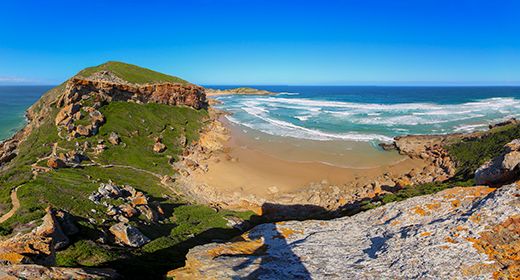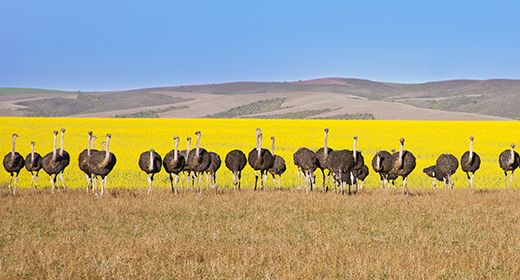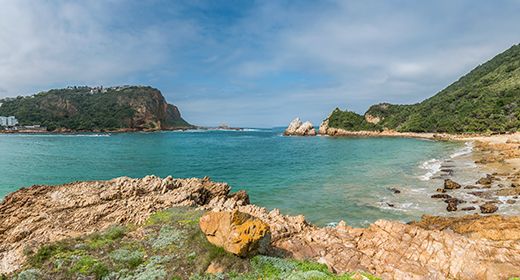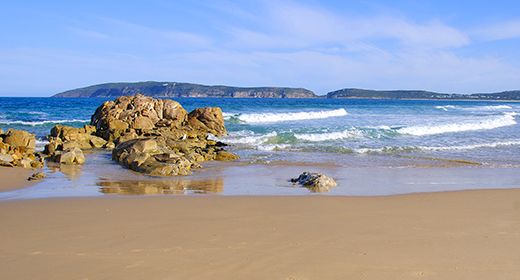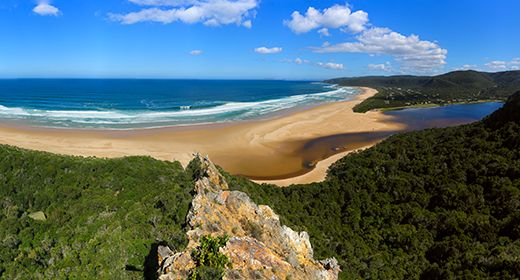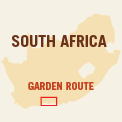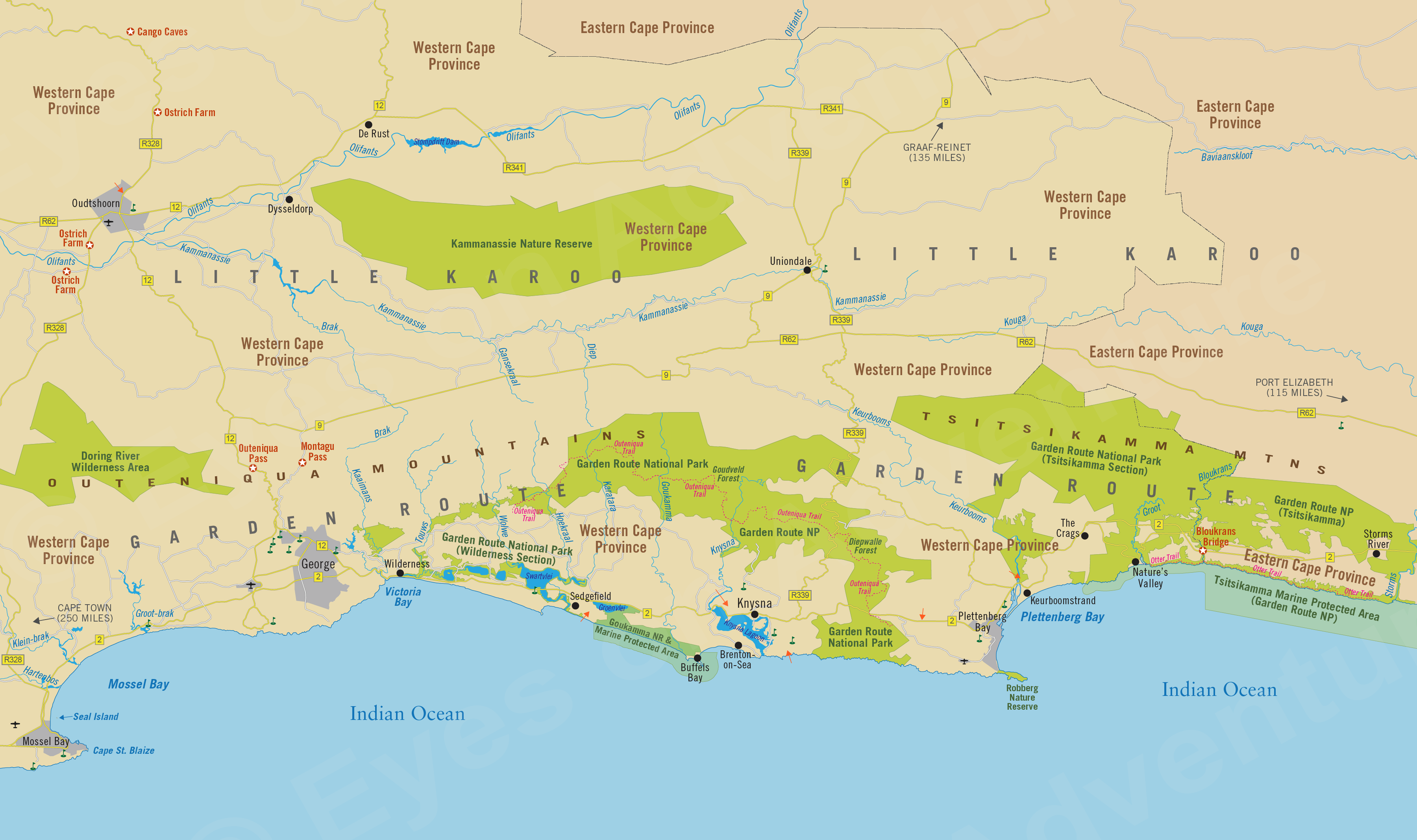Garden Route
(incl. Mossel Bay, George, Knysna, Plettenberg Bay, Tsitsikamma, Oudtshoorn, Little Karoo)
Region Links: Cape Peninsula, Cape Town, Cape West Coast, Cape Winelands, Eastern Cape, Garden Route, Gauteng Province, Johannesburg, Kruger Park & Lowveld, Kruger Private Reserves, KwaZulu-Natal, Madikwe, Overberg & Whale Coast, Pilanesberg & Sun City, Sabi Sand Reserve
Highlights
- Miles of coastline, spectacular natural beauty, and pristine beaches
- Great weather all year and mostly uncrowded (except during local holidays)
- Hiking trails throughout the region including some multi-day treks
- Excellent destination for families with plenty of activities for all ages
EOA Recommends: Hunter's Country House, Knysna Hollow Country Estate, Lake Pleasant Living Hotel, Tsala Treetops Lodge
South Africa's Garden Route is one of its most scenic and diverse regions. Most visitors self-drive along the coast, visiting the quaint towns and marveling at the spectacular coastal vistas, rugged cliffs, indigenous forests, protea-covered fields, sandy beaches, blue lagoons and ocean.
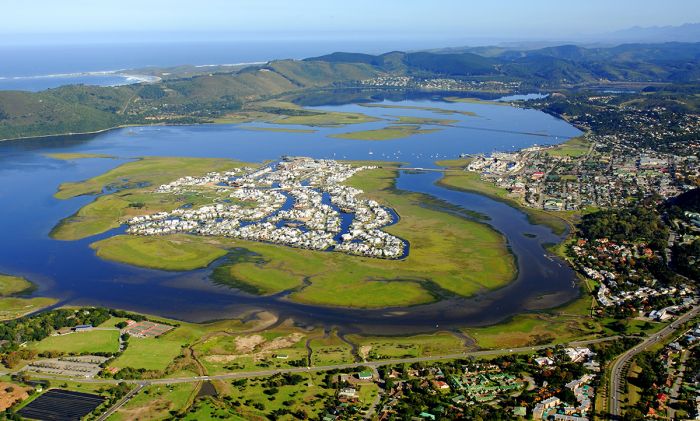
View over Thesen Island and the Knysna Lagoon
The Garden route has plenty of variety and is especially great for families with children. The region offers beaches, whale watching, numerous hiking trails, forests, adventure activities, animal sanctuaries, breathtaking scenery and numerous coastal towns with excellent restaurants and a wide range of accommodations.
All the towns along the Garden Route are particularly well suited for self-drive tourists and a very popular option is driving the 470 miles (756 kms) between Cape Town and Port Elizabeth. Navigating the roads in the Garden Route is very easy and unlike much of southern Africa, this is a destination that doesn't require an organized tour or a local guide to get the full experience.
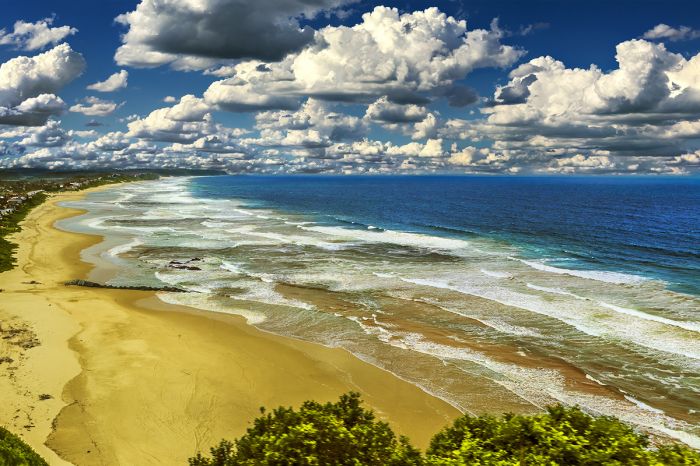
The lovely sand beach at Wilderness along the Garden Route
Spending at least a few days in the Garden Route region is highly recommended and choosing a home base is a good idea. Plettenberg Bay, Knysna and Wilderness all offer excellent options for accommodations.
These seaside towns have good restaurants (try the delicious seafood), wonderful art galleries, and plenty of craft shops. Most day excursions and activities can be done without a guide, but offshore activities like whale watching, fishing and shark excursions should be pre-booked ahead of time to ensure availability.
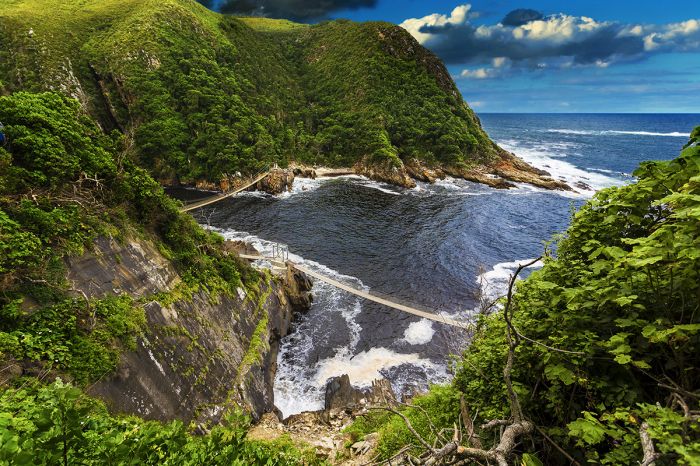
The suspension bridge over the Storms river mouth
Further inland and over the Outeniqua Mountains is the arid region of the Little Karoo (or Klein Karoo) and the town of Oudtshoorn, where you can visit the amazing Cango Caves and one of the interesting ostrich farms.
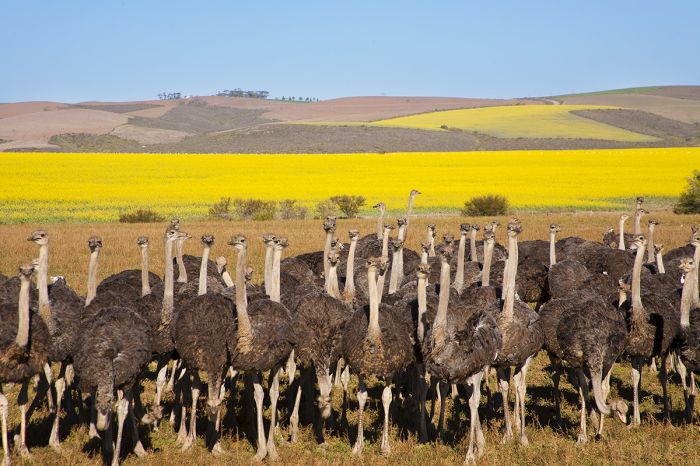
Ostriches at a farm near Oudtshoorn in the Little Karoo
Read More...
Garden Route, Garden Route National Park, George, Hiking, Knysna, Little Karoo, Mossel Bay, Nature's Valley, Otter Trail, Oudtshoorn, Outeniqua Trail, Plettenberg Bay, Storms River, Tsitsikamma, Wilderness
Garden Route
South Africa's Garden Route is the coastal region between Mossel Bay in the west and Storms River in the East. It is often overlooked by international tourists, who come to the country primarily for wildlife safaris and perhaps a visit to Cape Town, but the Garden Route is one of South Africa's most scenic and beautiful areas and has so much to offer.
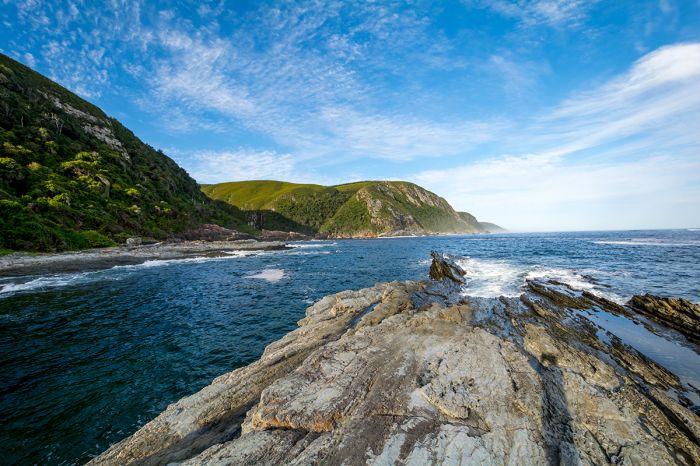
View of the coast in Tsitsikamma along the Garden Route
The term Garden refers to the lush, forested and floral beauty of the region, while Route is used because it is a very popular self-drive tourist route along the N2 roadway connecting the coastal towns.
The Garden Route is great for outdoor enthusiasts, with a variety of activities to suit all. Some of the world's best boat-based whale and dolphin watching is done out of Plettenberg Bay.
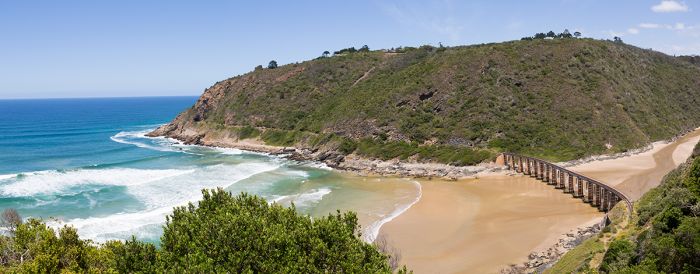
The Kaaimans River pass train bridge near Wilderness
There are well mapped and maintained hiking trails along the coast and in the forests, especially in the various sections of the Garden Route National Park. Well-known walking trails include the Dolphin Trail in Tsitsikamma, the Oystercatcher Trail in Mossel Bay, and the Garden Route Trail, which combines day hikes with some paddling through the wetlands in Wilderness.
If you want adventure, the highest commercial bungee jump in the world (700 feet/214 meters) is from the Bloukrans River Bridge. The canopy tour in Tsitsikamma allows you to 'fly' through the trees while harnessed to cables to get a birds-eye view!
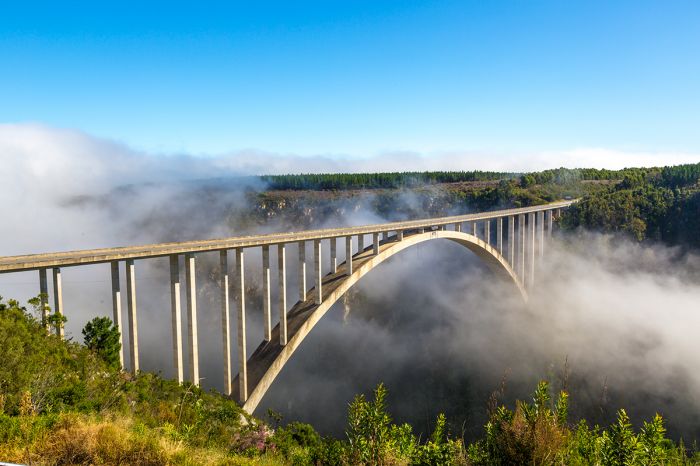
The world's highest commercial bungee jump over the Bloukrans river near Tsitsikamma
Inland and north from the coast are the Outeniqua and Tsitsikamma Mountain ranges, which divide the verdant Garden Route from the hot and arid Little Karoo region further to the north. Rivers flowing south from these mountain ranges cut through the Garden Route's rocky shores and beaches as they enter the Indian Ocean.
The entire coastline here is dotted with towering cliffs, pristine sand beaches, deep lagoons and small coves, inland lakes, diverse vegetation, including the remnants of one of Africa's great ancient woodlands, and quaint towns with excellent guest houses and boutique hotels.
Most international visitors to the Garden Route do so in a rental car and drive the coast between Cape Town and Port Elizabeth (either direction works well). Spending at least 3-5 days (and more if time permits) in this region is highly recommended.
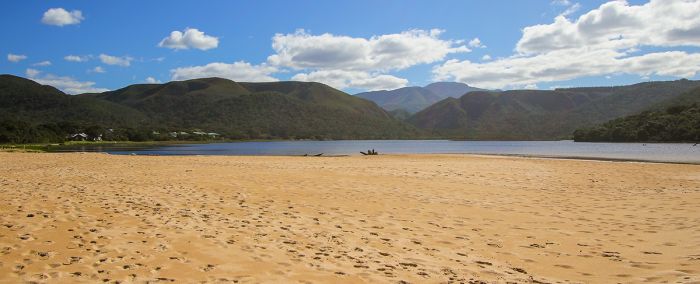
Nature's Valley lagoon
Garden Route National Park
Comprised of an amalgamation of already protected areas, including the Tsitsikamma Coastal National Park, the Tsitsikamma Marine Protected Area, the Knysna Lake National Area, Wilderness National Park, plus newly protected land, the Garden Route National Park (GRNP) was created in 2009.
The newly combined national park now covers 470 square miles (1 210 sq kms) along the coast between the town of George in the west and the Groot River in the east. Some 234 square miles (685 sq kms) of the park was already protected via the other parks and reserves and the rest was added to create this new and somewhat disjointed national park.
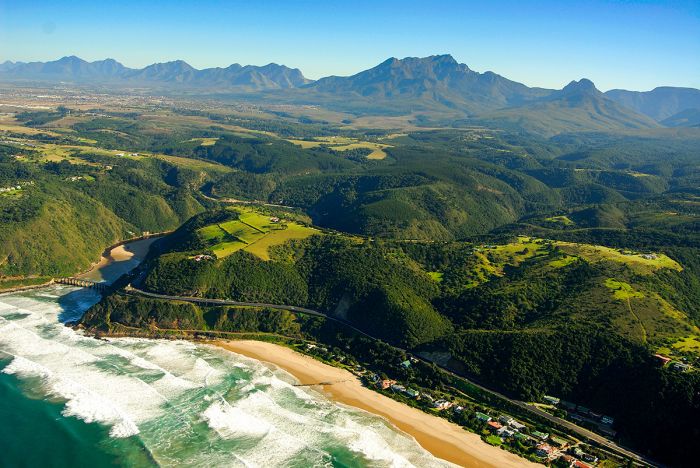
Aerial view over the small enclave of Wilderness and western end of the Garden Route National Park
The Tsitsikamma section includes land previously protected as the small Tsitsikamma National Park (proclaimed in 1964), extending for 50 miles (80 kms) along the coastline from Nature's Valley at the western end to the Groot River in the east.
The Tsitsikamma section also includes a Marine Protected Area (proclaimed in 1964) that extends 6 miles (10 kms) offshore, protecting the fish and other marine life, including whales and seabirds. The Tsitsikamma section is characterized by indigenous forests, beautiful and dramatic costal land, and the multi-day hike along the Otter Trail.
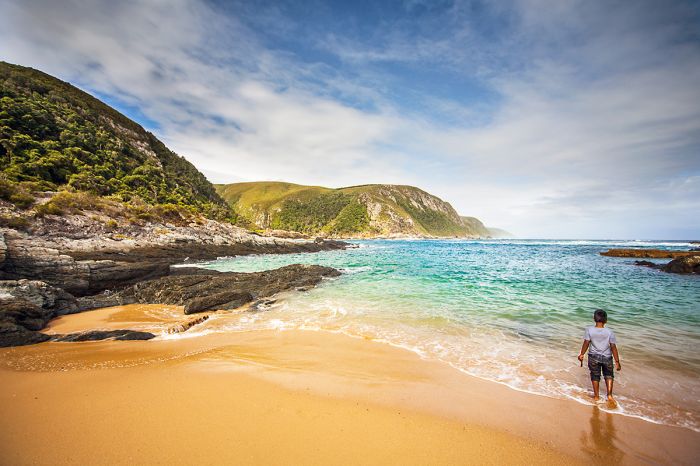
Exploring a deserted beach in the Tsitsikamma Section of the Garden Route National Park
The Wilderness section of the GRNP makes up the westernmost portion of the park, between the towns of George and Knysna. This section includes the previously protected land which was the Wilderness National Park (proclaimed in 1987).
The Wilderness section protects three portions of remaining indigenous forest, an abundance of 'fynbos' plants, and various lakes and waterways. There are also several significant archaeological sites protected in this section of the park.
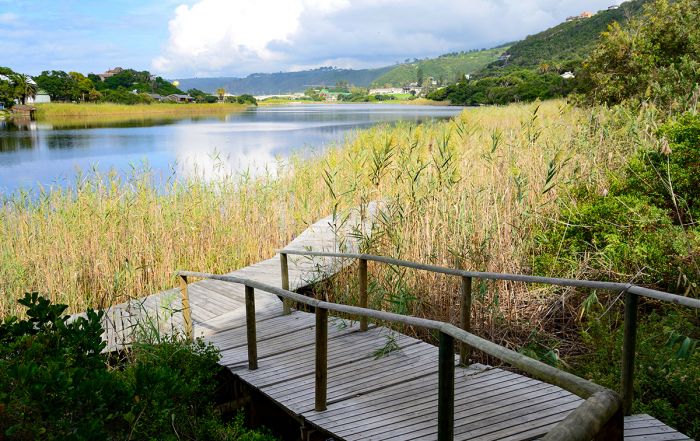
Boardwalk thru the wetland in the Wilderness Section of the Garden Route National Park
-- The Towns (West to East) --
Mossel Bay
Mossel Bay is the westernmost town along the Garden Route. The town is historically significant as the place where Portuguese mariners under the command of Bartolomeu Dias en route to India became the first Europeans to make landfall on South African soil. The sailors stopped to get fresh water and encountered the local Khoikhoi herders that lived and farmed in the region and a bloody encounter ensued.
The main attractions in Mossel Bay are its museums, especially the Bartolomeu Dias Museum Complex, the local oysters (delicious), some very well-preserved and beautiful stone buildings, golfing, and good beaches with safe swimming.
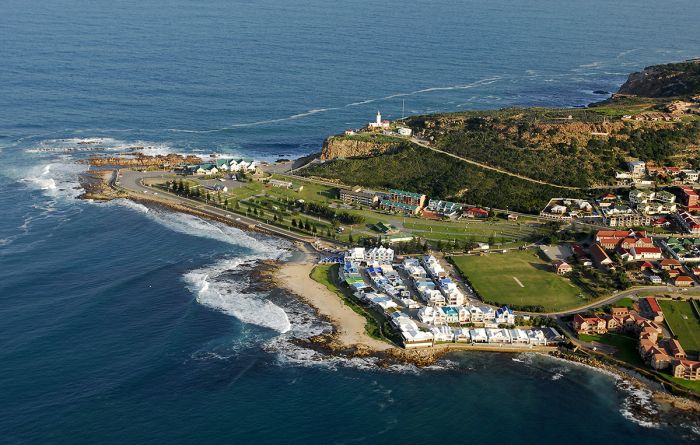
Cape St. Blaize in Mossel Bay
The town boasts has some of the only north-facing beaches (sunniest) on the coast, which means they are very popular with the locals and can get crowded on the weekends and holidays.
The well-known Oystercatcher hiking trail is a wonderful multi-day walking route along the coast, covering 48kms (30 miles). The trail can be done on a self-cater or fully-catered option. Nights are spent in guesthouses or cottages and the local guides add huge value. The typical tour take 4 days/5 nights, but shorter versions can be arranged.
The waters in the bay regular visits from dolphins, sometimes in groups of 500 or more, moving through the bay looking for food. The most common species seen are Heaveside's, common, dusky, and bottlenose dolphins.
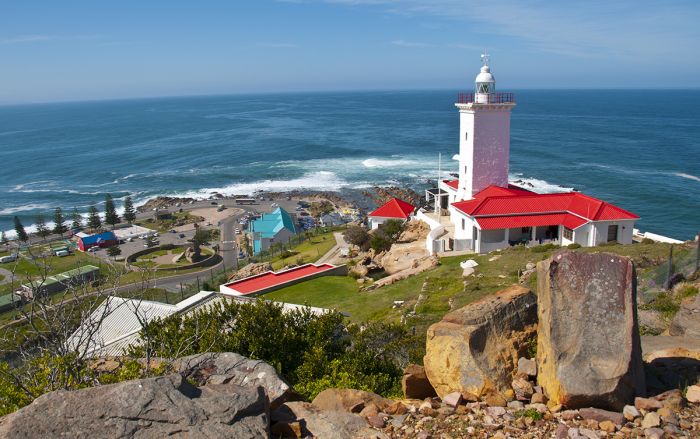
The Cape St. Blaize lighthouse in Mossel Bay
Southern right whales migrate from Antarctica to calve in the sheltered bays along the South African coast and many have their babies in Mossel Bay. The best season for whales in Mossel Bay is June thru October. Humpback whales, Bryde's whales, and orcas are also commonly seen here.
Just offshore in the bay is Seal Island, home to a breeding colony of 2 500 Cape fur seals and some African penguins. The waters around the island are frequented by great white sharks, which hunt the seals here. Boat cruises are available and if you want even more adventure, cage diving to see the sharks is also an option!
Mossel Bay is 240 miles (385 kms) from Cape Town and can be reached by road in around 4 hours if you don't stop along the way.
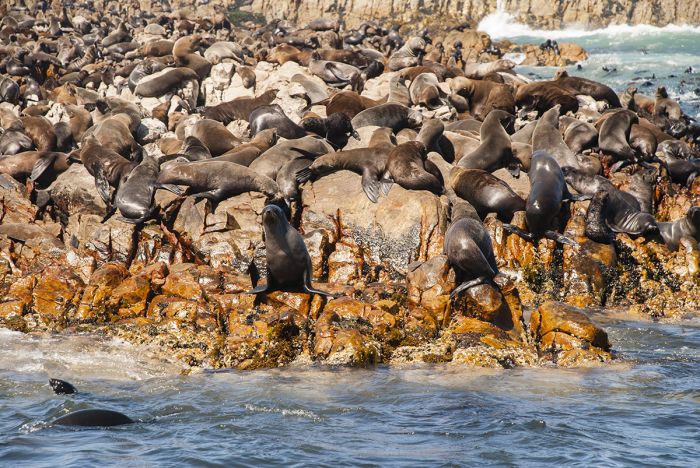
Cape fur seal colony on Seal Island, Mossel Bay
George
Founded in 1811, George is the largest town on the Garden Route and has the only true airport servicing the region. Anyone flying to George instead of driving in from either Port Elizabeth or Cape Town can obtain a rental car here. The town is located about 7 miles (11 kms) from the coast at the base of the striking Outeniqua Mountains.
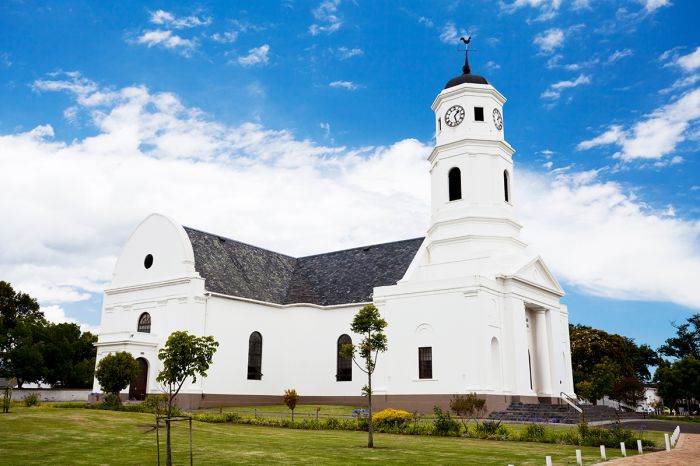
Dutch Reformed Mother Church in George built during the 1830s
George is mainly a commercial center and it's level of development and location away from the ocean make it a less attractive option for most tourists than Knysna or Plettenberg Bay, unless you are a golfer.
Aside from the numerous golf courses, the interesting Outeniqua Transport Museum features steam trains and other vintage vehicles and the town has some lovely old buildings and 19th-century churches.
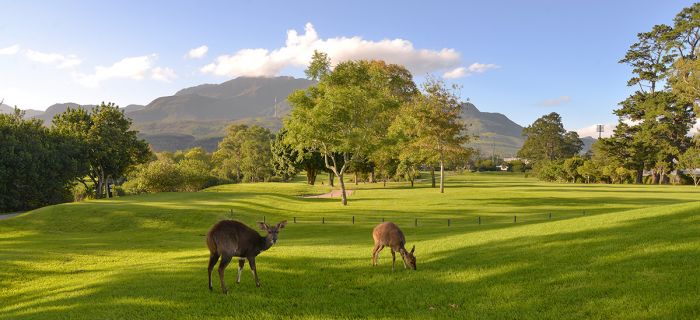
Bushbucks on the course at George Golf Club
Wilderness
Wilderness is a tiny and aptly-named coastal resort town backed by cliffs and towering forested dunes. Its pristine beach stretches between the Kaaimans and Touws rivers.
Spreading along the coast to the east of town for 19 miles (31 kms) is a spectacular wetland system of white-sand beaches, freshwater lakes, lagoons, and bird-rich estuaries, which are protected as part of the Wilderness sector of the Garden Route National Park. A network of walking trails winds through the lakes, beaches and forests and it's a bird-watcher's paradise. Canoes can also be rented for exploration via the waterways.
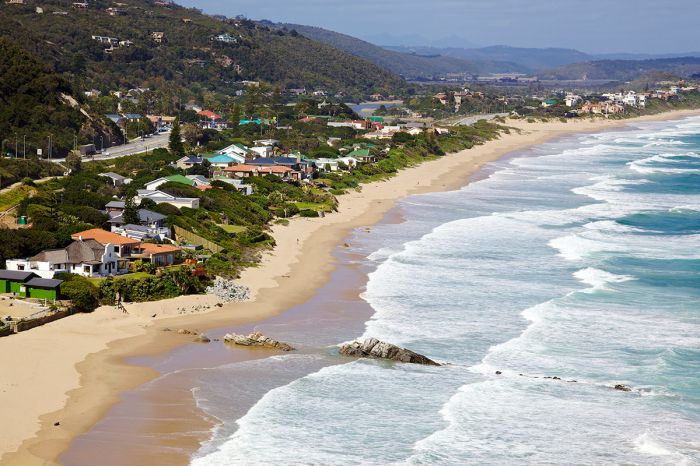
The beach at Wilderness in South Africa's Garden Route
The abundant natural beauty here has made Wilderness very popular and the hills above this stretch of coastline are dotted with upmarket vacation homes that blend into the greenery of the vegetated dunes. The town itself is minuscule and unobtrusive.
The beach is great for shorebirds and sometimes whales can be seen, but the currents here can be dangerous, so swimming is not advised.
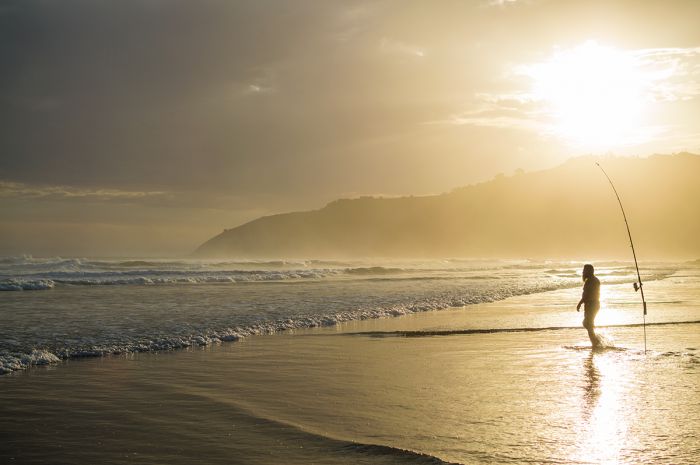
Fisherman at sunset on Wilderness Beach, Garden Route
Knysna
Knysna is one of the Garden Route's most popular destinations, with plenty of character and things to do. The town wraps around a large and beautiful lagoon, and is surrounded by indigenous forest. Settlers began harvesting the hardwood timber from these forests in the late 18th century and a permanent settlement was established here in 1825.
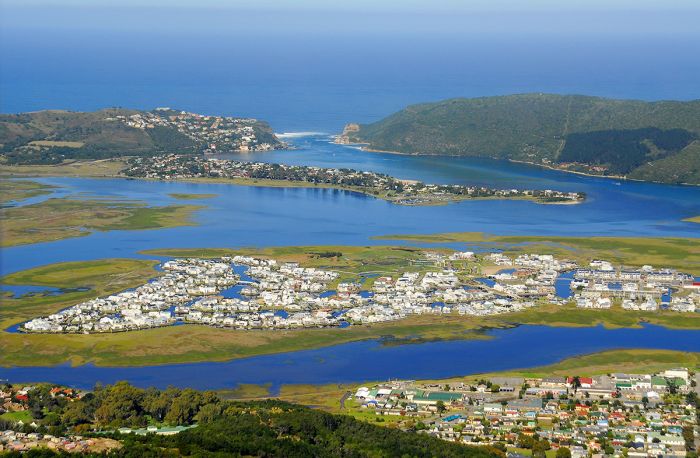
View over Knysna, the lagoon and out to the Heads
The lagoon's narrow entrance from the sea is guarded on either side by huge rock buttresses known as the The Heads. The approach from the sea is hazardous, which is why Knysna never became a major port. The eastern head is a small and exclusive residential neighborhood, while the western side is protected as part of the privately-owned Featherbed Nature Reserve. Organized tours to Featherbed offer exploration on foot and a chance to see the endangered Knysna Seahorse. Boating trips in the lagoon are also a good option.
Today Knysna is a modern, artsy, and socially diverse resort town, with the oldest section, called the town centre, situated on the northern side of the lagoon. Here you will find art galleries, restaurants, coffeehouses and various shops. The N2 is still a single lane cutting through this part of Knysna and traffic can be bad, so walking is recommended. Oysters harvested from Knysna Lagoon are a specialty and should not be missed.
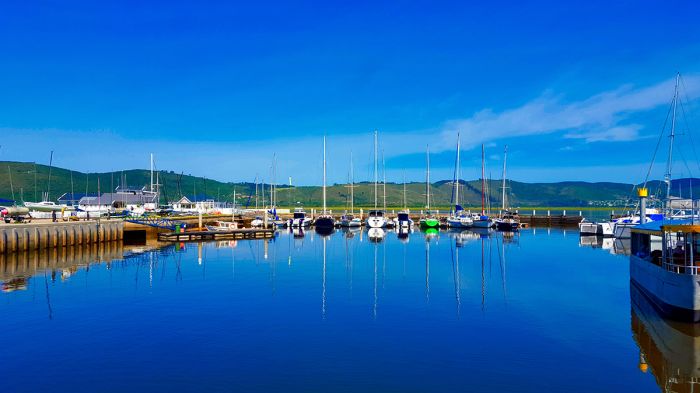
The Knysna waterfront at Knysna Quays
Knysna Quays, the town's waterfront shopping complex and yacht basin was constructed in the late 1990s and resembles the V&A Waterfront in Cape Town, albeit much smaller. The Quays are on the north side of the lagoon and offer a variety of shops, restaurants and hotels overlooking the lagoon. Thesen's Island sits in the lagoon and is connected by a causeway, with more shopping and eateries.
Although Knysna is a true seaside town, there are no beaches actually in the town (unlike Plettenberg Bay and Mossel Bay), but there are some great beaches not far away. The beach between Brenton-on-Sea and Buffels Bay is a beautiful, 4-mile (6-km) beach is great for walking but has dangerous currents, so swimming is not recommended. Just west of Buffels Bay is small beach with good surfing and body-boarding.
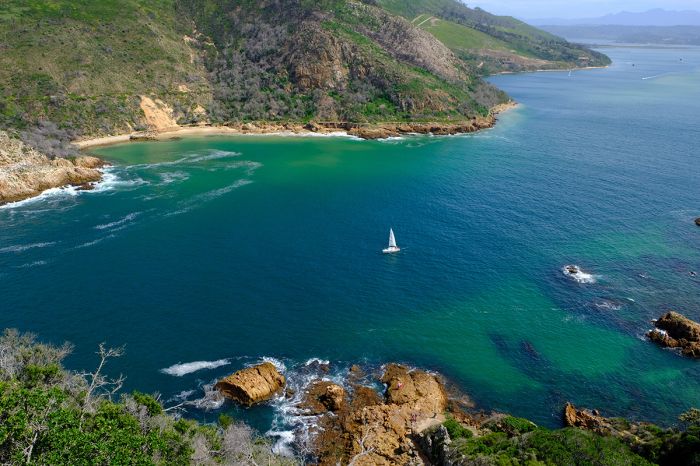
Boats in Knysna Lagoon
The forests just north of town are perhaps the best reason to visit Knysna. These forests, mere fractions of the once magnificent woodlands, were once home to thousands of elephants. Today there are only a handful left and the Knysna Elephants have gained a near mythical status. These remnant forests are truly beautiful and now fully protected. Wildlife still exists here, including vervet monkeys, blue duikers, bushbucks and plentiful forest birds.
Diepwalle Forest, now incorporated into the Garden Route National Park (GRNP), offers three well maintained walking trails, each one covering 7-10 kms. The hikes are not difficult and each can be completed in around 3-4 hours. The scenery and dense yellowwood trees are magical. The nearby Goudveld Forest, also part of the GRNP, offers more hiking trails.
The 7-day Outeniqua Trail traverses the forests north of Knysna and is one of the best treks in South Africa.
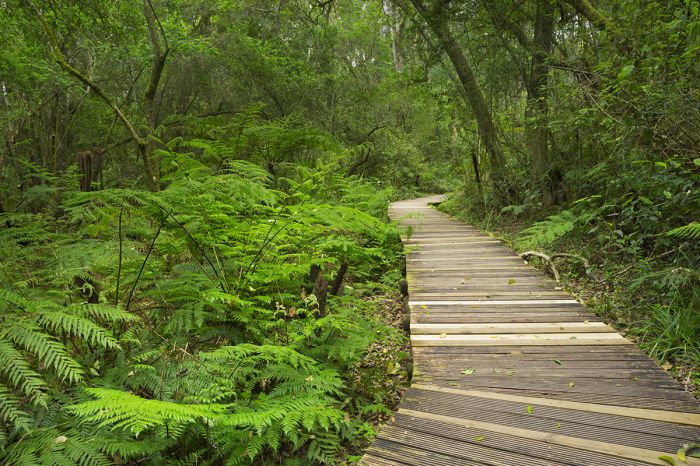
Walking trail in the Garden Route National Park near Knysna
Plettenberg Bay
Plett, as it is known locally, is an upmarket resort town that is especially popular with local South Africans. During December and especially over the Christmas and New Year's holidays, the town is inundated by forty thousand locals who come to stay at their vacation properties and enjoy the beach and good weather.
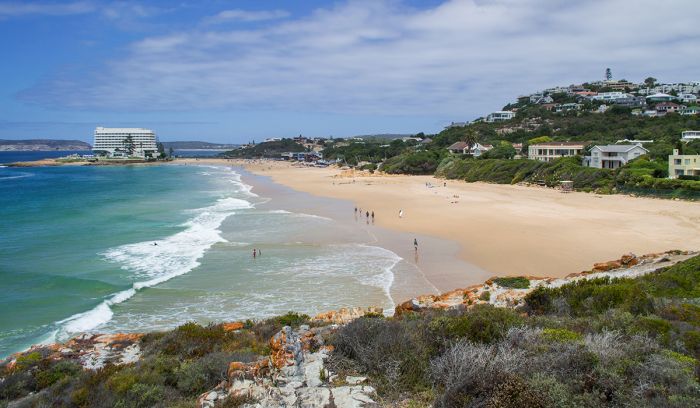
Plettenberg Bay beaches and the Beacon Island Hotel in the distance
The coastline around Plett is one of the prettiest you will ever see and the bay was dubbed Bahia formosa ('the beautiful bay') by the Portuguese sailers who first saw it in 1497.
Central Beach in town offers good swimming and kayaking. Keurboomstrand is 6 miles (10 kms) east and offers a remote and beautiful sand beach and a lovely lagoon, but is less safe for swimming. Lookout Beach is just east of town and offers great swimming.
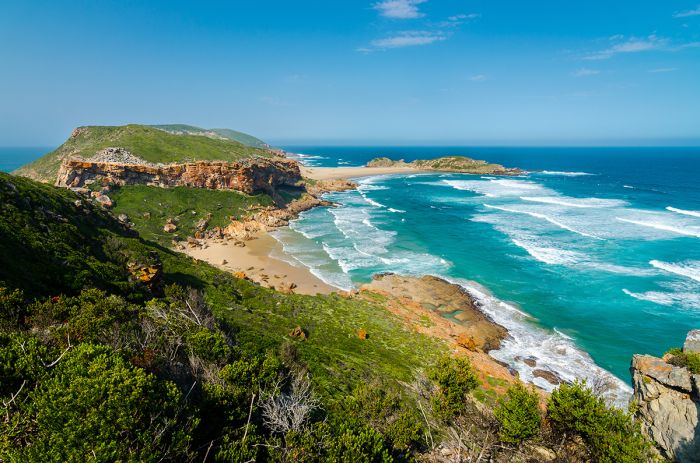
The peninsula at Robberg Nature Reserve, south of Plettenberg Bay
Five miles (8 kms) southeast of town is the spectacular Robberg Peninsula, which has one of the Garden Route's best hikes. The 4-hour circular walk around the spectacular rocky Robberg Nature Reserve offers amazing views of the wild coastline, the ocean, and a great chance to see seals, dolphins, and whales.
Plett has some of the world's best boat-based whale and dolphin watching and excursions are offered at Central Beach. There are numerous viewpoints on shore that offer excellent whale viewing between June and October, when Southern right whales migrate here to calve.
Besides whale-watching, Plett is popular for surfing, swimming, fishing and hiking.
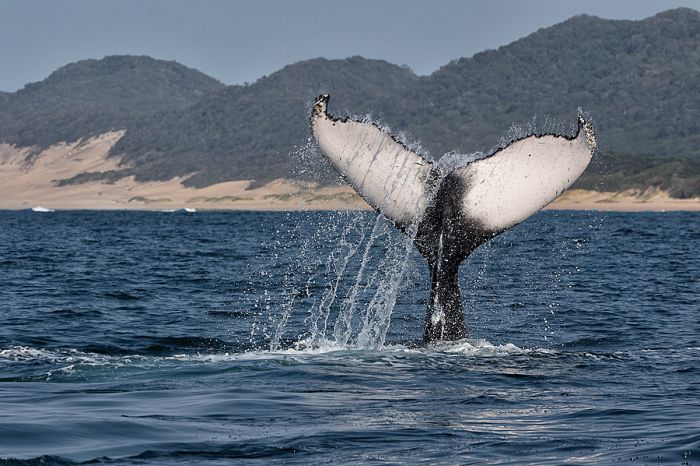
Plettenberg offers superb whale watching
Plett's Beacon Island Hotel, while something of an eyesore, was originally a whale-processing factory that was built in 1806. Huge demand for whale oil and bone (used for Victorian corsets), led to large-scale whaling from Western Africa around the cape and up to Mozambique.
By 1918 the Southern right whale numbers had been decimated and Plett was one of only four processing facilities that remained open. Whalers then turned to harvesting fin and blue whales, which by 1960, had also been drastically depleted. In 1979, South Africa banned all whaling activity.
The Crags is a small suburb located 10 miles (16 kms) northwest of Plett with a collection of managed wildlife viewing facilities that are a great place to take children. There is The Elephant Sanctuary, Monkeyland, Birds of Eden, and the Jukani Wildlife Sanctuary. All offer a home in for animals that were orphaned or saved from a life as pets.
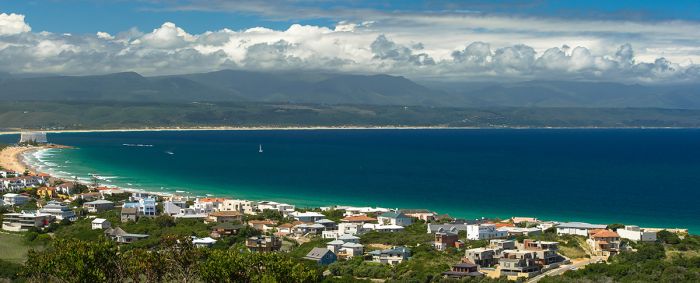
Plettenberg Bay, also called Bahia Formosa
Tsitsikamma
The Tsitsikamma Section of the Garden Route National Park is a narrow strip of coastline covering 50 miles (80 kms) from Oubosstrand in the east to Nature's Valley in the west. Managed as it own park, Tsitsikamma offers spectacular scenery, with rocky cliffs and gorges, beautiful hardwood forests, remote sandy beaches, estuaries and tidal pools.
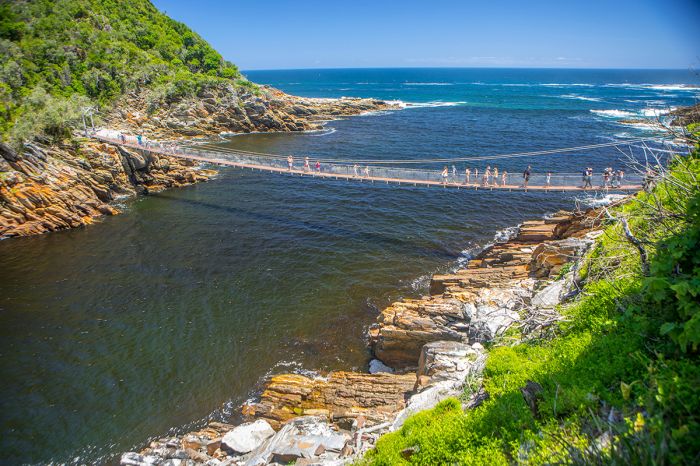
The suspension bridge over the Storms river mouth in Tsitsikamma
The park was declared in 1964 and includes the country's first marine protected area, which extends 6 miles (10 kms) out to sea. The 5-day Otter Trail is one of the best ways to experience this wild coastline. There are also plenty of short hikes throughout the park that can be completed in a few hours.
Storms River is a tiny, isolated town situated inland from the coast right inside the forest. The little village is always full of activity, with nature lovers booking outdoor activities.
Storms River Mouth (the SANParks camp) is located in the national park along the coast and is not the same place as the village. Activities on offer around Storms River include mountain biking, hiking, zip-line canopy tours, boat tours, and Segway tours.
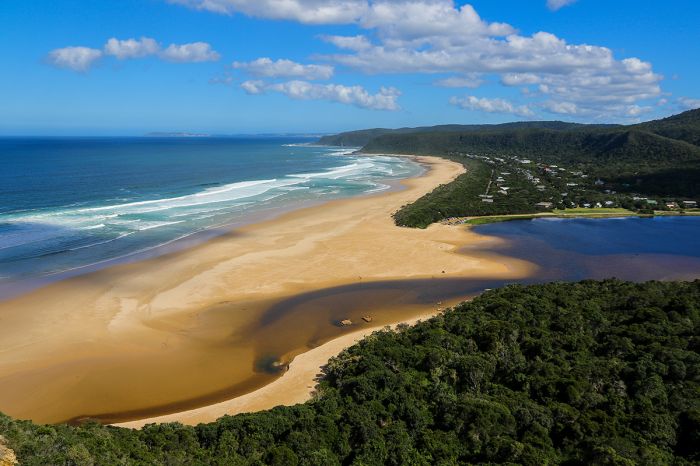
Nature's Valley beach and the Groot river mouth
Nature's Valley is a small residential town at the western end of Tsitsikamma on the Groot river lagoon. Its 12-mile (20-km) sand beach and miles of indigenous forest make it a truly magical place to visit. Nature's Valley is one of the least developed places on the Garden Route and local legislation prohibits housing developments, hotels and buses. There is only a single restaurant and a shop and the town blends into the surrounding forest. There is a large network of hiking trails that extends deep into the ancient yellowwood forest.
To the west of Nature's Valley is the Bloukrans river, which forms the border between the Eastern Cape and Western Cape provinces. Adrenaline junkies may consider stopping at the N2 bridge over the river, as it offers the world's highest commercial bungee jump!
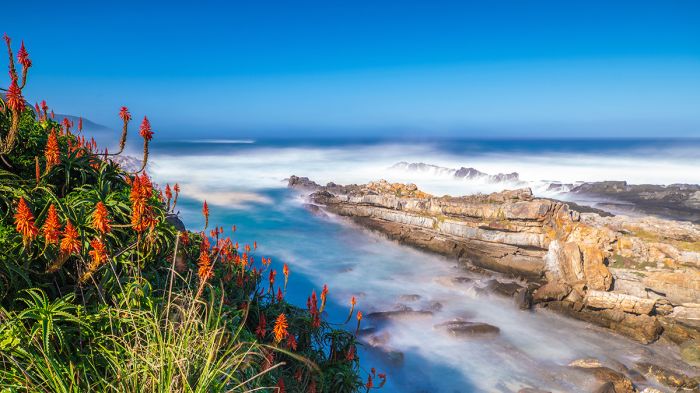
Aloes growing along the coast in Tsitsikamma
Hiking the Garden Route
Outdoor activities, and in particular nature walks and hiking, are what visiting the Garden Route is all about. The region is packed with short, easy-to-do hikes that can be done in a few hours. The forests and coastal regions in the Garden Route National Park offer numerous well-maintained trails that can be done without booking ahead and on one's own without a guide.
For those seeking a more adventurous trek, there are also some multi-day hikes where you stay in chalets (or huts) at night and walk for 3-7 hours per day. The most popular of these longer hikes are the Outeniqua Trail and the Otter Trail. These trails must be pre-booked because the overnight huts can only accommodate a certain number of hikers.
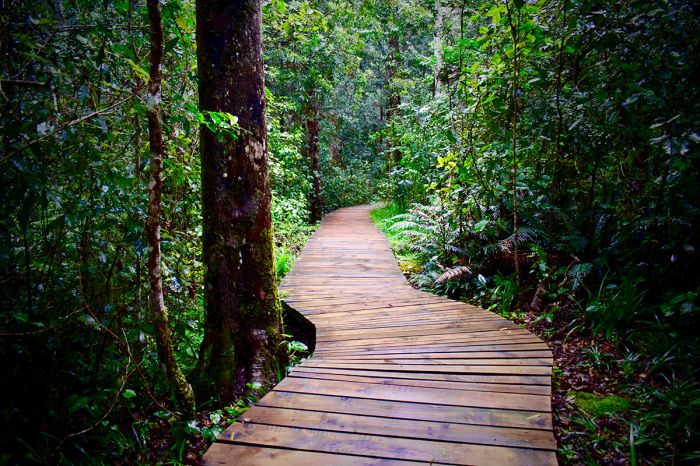
Boardwalk through the forest in Tsitsikamma
THE OUTENIQUA TRAIL
The Outeniqua Trail starts just northwest of Sedgefield and takes 7 days, ending close to the N2 road between Knysna and Plettenberg Bay. The trail explores the Garden Route National Park north of Knysna and has some steep, challenging parts, but anyone with good fitness can do this trail. The huts are well maintained and the forests are safe and beautiful. Parking your car near the end of the trail means you can skip the last overnight hut and just drive back to accommodation nearby. This trail can often be booked a month or less in advance.
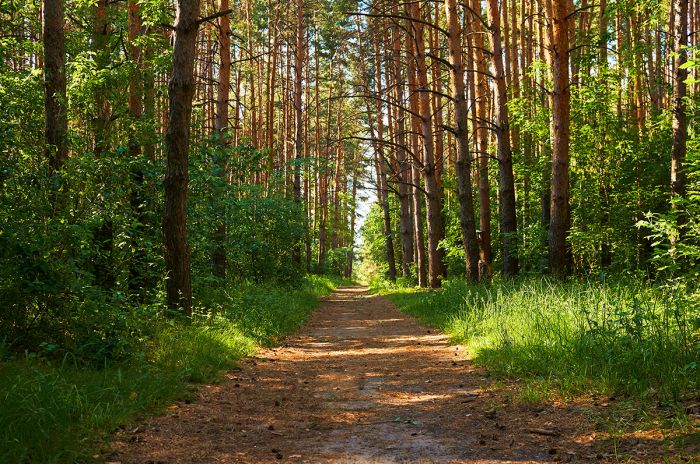
Hiking trail in the Garden Route National Park near Knysna
THE OTTER TRAIL
The Otter Trail is South Africa's oldest and most iconic hike. It takes 5 days and traverses the spectacular coast starting at the Storms river mouth and ending to the west at Nature's Valley. The trail is named for the reclusive Cape clawless otter, which lives in the streams and estuaries of the region.
The route is moderately demanding and has some 'walk-through' river crossings. The most difficult part is a swim across the Bloukrans river and a subsequent climb by rope up the steep bank. The scenery is truly spectacular. The trail is extremely popular and pre-booking is required, usually up to one year in advance (except in winter), with a maximum group size of 12.
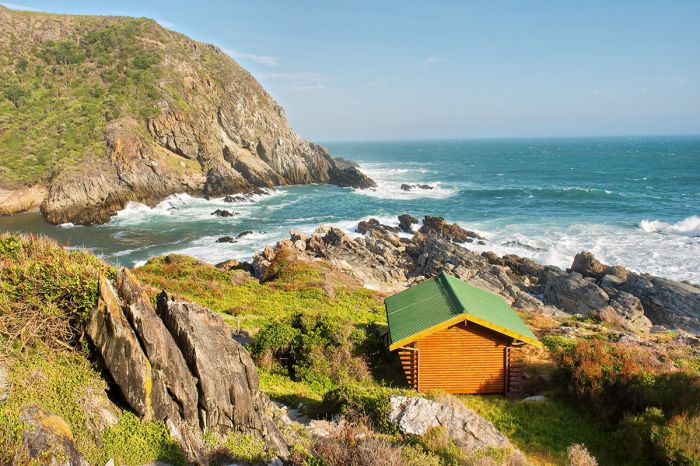
One of the overnight chalets on the Otter Trail
Little Karoo
The Little Karoo, separated from the Garden Route by the Outeniqua and Tsitsikamma Mountain ranges (both part of the Cape Fold Mountain Range), is an arid and minimal land and in sharp contrast to the lush Garden Route. The region is characterized as a semi-desert, with very low rainfall, arid air, and extreme contrasts in temperature, with blazing hot days and cold nights. Its is also a starkly beautiful region. It is also called the Klein (Afrikaans for 'small') Karoo (derived from the San language and meaning 'thirst').
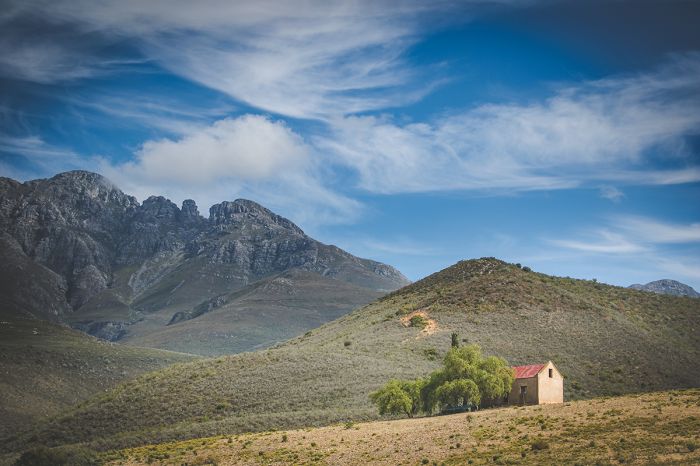
Little Karoo landscape near Uniondale
A great alternative to the N2 road along the coast is Route 62 through the dry Karoo. This route begins in Robertson to the west and is far less developed, taking you through some dramatic mountain passes and spectacular scenery, with some interesting small towns along the way.
Oudtshoorn is worth a visit if you're in the Garden Route or driving the R62. The town is famous for its ostrich farms, which have been around since the 1860s, when ostrich feathers were in high demand for use by European nobility as fashion accessories, especially on women's hats. They were in such demand that their value by weight was nearly equal to that of diamonds. The town of Oudtshoorn experienced a major economic boom and the farmers became rich. Demand for ostrich feathers eventually declined completely as fashion trends moved on.
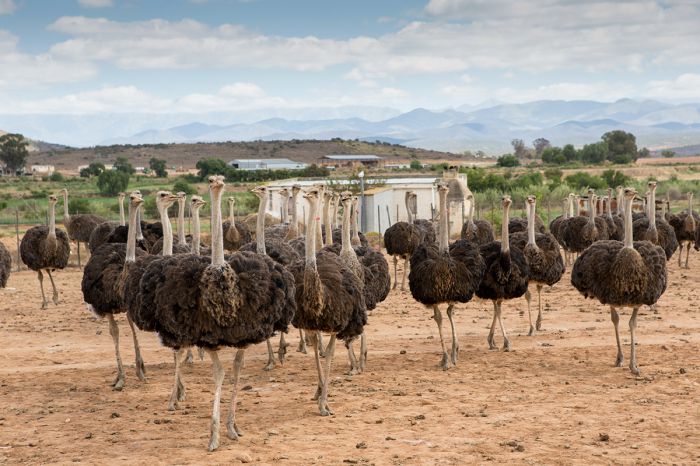
Ostriches near Oudtshoorn in the Little Karoo
After World War II, ostriches became useful for farmers as a totally fat- and cholesterol-free meat and for its distinctive leather. Today the region's main export is agricultural seed, but ostrich farming remains an important business, especially for tourism and there are several ostrich farms here that offer tours and a chance to try ostrich meat.
Just outside Oudtshoorn are the very popular Cango Caves, where you can take a tour and see the beautiful stalactite and stalagmite formations.
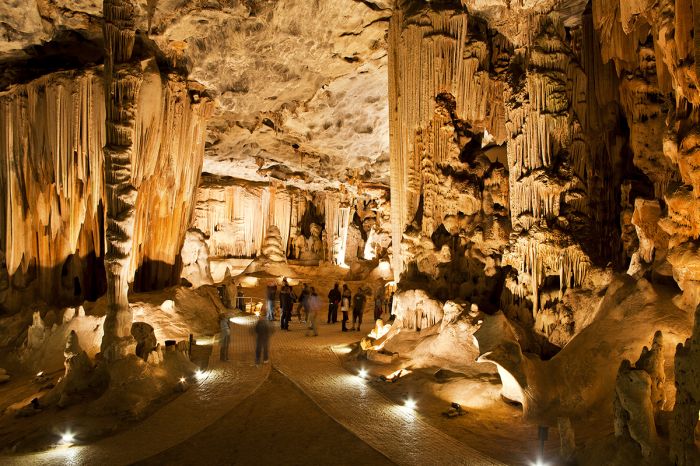
The Throne Room in the Cango Caves
Read More...
Garden Route, Garden Route National Park, George, Hiking, Knysna, Little Karoo, Mossel Bay, Nature's Valley, Otter Trail, Oudtshoorn, Outeniqua Trail, Plettenberg Bay, Storms River, Tsitsikamma, Wilderness
Great Good Fair Poor
- Jan
- Feb
- Mar
- Apr
- May
- Jun
- Jul
- Aug
- Sep
- Oct
- Nov
- Dec
There is no best time to visit South Africa’s Garden Route, as weather along the coast is wonderful all year.
The Garden route experiences a mild and temperate Mediterranean climate year-round, but unlike much of Southern Africa, it does not have a well-defined season with regards to rainfall. Rain along the coast here can fall at any time throughout the year.
Opposite to most of the country, the Garden Route receives the majority of its rain in the winter months due to the winds off the Indian Ocean. Much of the rain falls during the night.
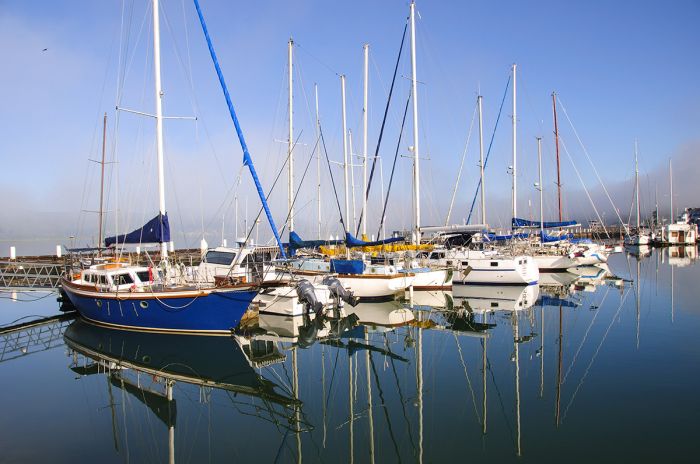
Knysna harbor
The summer months (November - February) are a bit warmer than the winter, with daytime temps around 75-86°F (24-30°C). Temperature begin cooling slightly in April, but even the winter months (June - August) are pleasant during the day. Nights in winter can be chilly.
The Christmas and New Year’s season (mid-December to mid-January) is a time to avoid, as families from Johannesburg and elsewhere in South Africa arrive in huge numbers for their holiday in the Garden Route. February thru April is much better, with great weather and no crowds. Winters (May - August) are the low season and some accommodations may be closed.
Whale watching is best from late June thru October, with September being the peak season. Wild flowers are in full bloom during the during these same months.
The Little Karoo is very hot during they day in summer (November - March), but comfortable at night. Winters are generally pleasant, with warm sunny days, but very chilly at night.
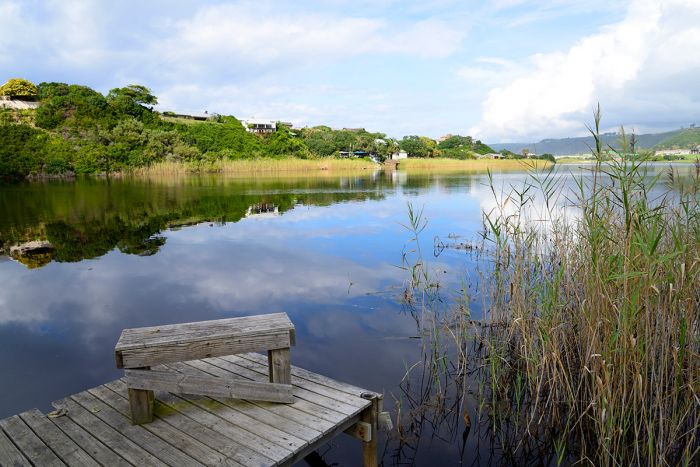
Lagoon boardwalk east of Wilderness on the Garden Route




